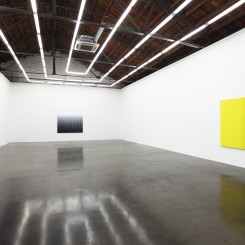Xie Molin Solo Exhibition
Beijing Commune (798 Art Factory, 4 Jiuxianqiao Road, Chaoyang, Beijing). Sept 1 – Oct 13, 2012.
These machinic paintings by Xie Molin began with the purchase of two saws from a hardware shop. Years later, they hang in the gallery — paint as refined as the metal objects that seeded the idea. The works employ a machine specially conceived by the artist. Each time, a designis programmedinto a computer along the axes X, Y and Z (this was also the title of Xie’s first solo exhibition last year), and a toothed arm moves in accordance across the liquid surface of the paint, ploughing and pressing it into a surface of pattern which might expand or contract in crossing waves, ripples or geometric furrows.
“Painting”: a word wherein the all-important suffix creates a verb from a noun, or, equally, where a substance begets an object — from paint, a “painting.” Xie Molin has remarked that people say painting is long dead. The conventional verb may be, perhaps, but not the nominal object, as his works prove. One wonders what Greenberg might have said. Such linguistic twists might seem superfluous, but that these works are less acts of “painting”, somehow, than simply paint — heightened, realised — and less “created” (in the traditional sense of artistic expression), than made, is important. For they are so much about the consistency and behaviour of a substance, almost to the point being existential. They are also completely refined; for each work on the gallery wall, there may be as many as ten rejects of that same work left on the studio floor because they are not perfect. It is like quality control, and only the approved object is released into circulation.
This solo exhibition at Beijing Commune is a memorable and absorbing experience. The best works are the large monochrome pieces in which named perception — the gaze or glance — somehow dissolves amongst a myriad of lines and the play of light. The white work “Gradation No. 3” (2012), for example, achieves a skilful tension between satisfaction and confusion, as if combining the primal sensation of clearly seeing the line of a horizon, and the compulsion to stare at an optical illusion. Less affecting are the two smaller works in which the mixture of colours and comparatively heavy texture show how fine-tuned the exercise needs to be to succeed.
But whilst one can emphasise the abstraction, machine-ism and qualitative refinement of these paintings, they finally impart a humanistic aura. This is not connected with the socio-political theme which Xie claims for some of the new works. In “The Confident Yellow” (2012), for example, he asserts a positive hue — as yellow has always been in China, clothing the Emperors — in comparison with the historical labelling by outsiders of “yellow” Chinese skin. The nature of the paintings somehow precludes such an overtone — its expansive concern fails to gel with the substance and surface-orientated focus of the work. Instead, humanistic value lies in the fulfilment of making such works of art, of deigning their patterns, in judging the success of each manifestation, and in governing the process by which they come into being before sanctioning their display. In such making is indicated an arrival, the journey to which has been conceived and controlled entirely by the artist, and in a way that feels more powerful than what is present in painterly art works. After such an exercise, one wonders indeed what the next move in Xie Molin’s practice will be — how, beyond the variation of pattern, colour and shape, this line of work will evolve.
